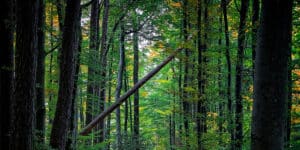By: Shelby McCullough| Published: January 2, 2023

Trees are an essential part of the environment, providing shade, protection, and beauty to your home and neighborhood. But what happens when a tree starts to lean? Is a leaning tree dangerous, and how should you deal with it?
In this guide, our team at McCullough Tree Service answers these important questions.
What Might Cause a Tree To Lean?
Trees don’t just begin leaning out of the blue. You can always trace leaning to an underlying cause, which may be due to the following factors:
- Not enough sunlight: Trees need the sun, so they naturally grow upright toward it. However, a young tree might grow crooked if nearby trees or buildings block keep it from getting adequate sunshine. While it isn’t very aesthetically pleasing, a tree leaning for this reason is actually safe and healthy.
- Strong winds: Another common cause of leaning trees is strong winds. Healthy trees have deep roots and solid trunks, but high winds may continually pummel them and force them to lean. Many homeowners struggle with this issue along Florida’s coastline.
- Heavy rains: Is a leaning tree dangerous? The answer is yes, if the lean results from prolonged periods of heavy rainfall. Heavy rains can soften the soil and cause the roots to lose their grip, making a tree more susceptible to leaning and falling over completely.
Can You Save a Leaning Tree?
Some leaning trees are hazardous, and you’ll want to remove them before they topple over and damage property or cause personal injury. On the other hand, some leaning trees are perfectly healthy and can grow straighter with a bit of care. It depends on the tree’s size and what caused it to lean in the first place.
For example, you could save a leaning tree that isn’t getting enough sunlight by cutting down overhanging trees or removing nearby structures. This will give the tree full access to the sun and encourage it to grow upright. However, removal might be your best option if strong winds or heavy rain have damaged the tree and caused it to lean.
When Should You Remove a Leaning Tree?
You can’t go back after removing a tree. Not all leaning trees require removal, so you must ask yourself, “Is a leaning tree dangerous?” before deciding to chop it down. In some cases, though, tree removal may be your best option.
Visible Root System
Roots are the main support for a tree. They keep the tree trunk tethered to the ground, balancing the branches and fighting against the wind, rain, and other natural elements. If you can see a leaning tree’s root system, it’s a good sign you should remove it.
A tree with a visible root system is cause for major concern. The more a tree leans, the more it pulls up the roots and compromises its support structure. The next strong gust of wind or heavy rainstorm could make it fall over.
Near Property or People
Do you have a leaning tree close to your home? Would it possibly injure someone if it falls over? If you answer yes to either of these questions, it might be time to get our professional tree service in Orlando, FL, to remove it.
The safety of your home and family aren’t the only factors to consider. A leaning tree could fall on electrical lines and cause a power outage or land on a car and cause you to be late to work—or worse. You’ll want to remove a leaning tree if it poses even a slight risk.
Known Damage
Another way to know when to remove a leaning tree is by checking for damage. In some instances, you might need to call a tree surgeon to diagnose the issue. But some damage will be obvious and indicate it’s time to remove the entire tree.
Hurricanes, heavy rains, lightning strikes, and other natural disasters can severely damage a tree. If your leaning tree shows the following signs of damage, consider removing it:
- Dead branches
- Large, broken limbs
- A cracked trunk
Diseases or Hollow Trunk
Hollow trees can be dangerous because they are more likely to fall over than healthy ones. They also pose a risk for people and buildings nearby if the tree does fall since leaves and branches on the trunk cannot absorb the impact of its fall. A diseased tree is just as dangerous for these same reasons.
Some trees may look perfectly healthy on the outside but have all kinds of problems under the bark. Fungi, pests, and numerous diseases can eat away at a tree and leave it vulnerable to falling over. You’ll want a specialist to inspect the tree and let you know if removing it is your number one option.
Leaning Suddenly
Was a tree in your yard straight and tall one morning and suddenly leaning the next day? If so, you will probably need to remove it. Trees don’t suddenly start leaning on their own—it’s a symptom of deeper, more serious issues if your tree starts leaning overnight.
A damaged root structure could be the underlying cause of a suddenly leaning tree. It may also result from a tree disease. Either way, you don’t want to risk having it fall over—contact a certified arborist to have the leaning tree removed.
Get Our Expert Help From McCullough Tree Service
Some leaning trees require immediate attention, while others are fine just as they are. Now that you know the answer to “Is a leaning tree dangerous?” and that it’s a good idea to remove it, the next step is deciding what to do. An experienced company like McCullough Tree Service can help you understand the situation and implement the right solution.
At McCullough Tree Service, we provide a wide variety of tree care services in Lockhart, FL, and the surrounding area. Our certified arborists can detect issues quickly and answer any questions you may have about leaning trees (including why trees fall down). To learn more about our top-quality services and get a free estimate, call us today at (407) 734-5854!

